Readings Newsletter
Become a Readings Member to make your shopping experience even easier.
Sign in or sign up for free!
You’re not far away from qualifying for FREE standard shipping within Australia
You’ve qualified for FREE standard shipping within Australia
The cart is loading…






This is the first Australian text on the law of deeds. Until now, practitioners have had to use Norton A Treatise on Deeds, an English text of 1928. Seddon on Deeds comprehensively sets out the law applicable to the use of deeds by lawyers, referring, so far as possible, to Australian cases, and covering the 20th century Commonwealth, State and Territory legislation that modifies the ancient common law rules.\n\nThe book examines in Chapter 1 the pros and cons of using deeds. There are many ways that deeds can be defective. Chapter 2 sets out the law on execution of deeds for all types of legal entities. Chapter 3 examines the elusive concept of delivery and the use of escrows. Chapter 4 analyses the legal consequences of altering a deed, either inadvertently or by agreement. The 400 year old troublesome rule in Pigot’s Case still applies in all jurisdictions except for New South Wales. Chapter 5 considers issues of interpretation of deeds, a particularly important topic when using a settlement deed. Chapter 6 examines enforcement and remedies. Enforcement concentrates on the who question: who can enforce and who is bound? Remedies focus on the how question. Chapter 7 covers the various ways that a deed is discharged.\n\nSeddon on Deeds provides important insights for practitioners on the hazards that can be encountered in using deeds and sets out how to ensure that a deed is legally sound and how to avoid trouble.
$9.00 standard shipping within Australia
FREE standard shipping within Australia for orders over $100.00
Express & International shipping calculated at checkout
This is the first Australian text on the law of deeds. Until now, practitioners have had to use Norton A Treatise on Deeds, an English text of 1928. Seddon on Deeds comprehensively sets out the law applicable to the use of deeds by lawyers, referring, so far as possible, to Australian cases, and covering the 20th century Commonwealth, State and Territory legislation that modifies the ancient common law rules.\n\nThe book examines in Chapter 1 the pros and cons of using deeds. There are many ways that deeds can be defective. Chapter 2 sets out the law on execution of deeds for all types of legal entities. Chapter 3 examines the elusive concept of delivery and the use of escrows. Chapter 4 analyses the legal consequences of altering a deed, either inadvertently or by agreement. The 400 year old troublesome rule in Pigot’s Case still applies in all jurisdictions except for New South Wales. Chapter 5 considers issues of interpretation of deeds, a particularly important topic when using a settlement deed. Chapter 6 examines enforcement and remedies. Enforcement concentrates on the who question: who can enforce and who is bound? Remedies focus on the how question. Chapter 7 covers the various ways that a deed is discharged.\n\nSeddon on Deeds provides important insights for practitioners on the hazards that can be encountered in using deeds and sets out how to ensure that a deed is legally sound and how to avoid trouble.